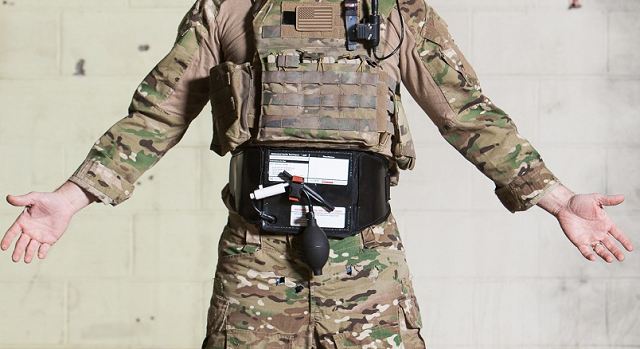US Special Forces medics save live with Abdominal Aortic Tourniquet for pelvic wound 0801144
| a | |||
Abdominal Aortic Tournique for medics |
|||
| Wednesday, January 8, 2013 11:17 AM | |||
| U.S. Special Forces medics save live with Abdominal Aortic Tourniquet for pelvic wound. | |||
Some
special operations medics in Afghanistan now have a new device that helps
save soldiers with the most common cause of preventable death in combat:
a traumatic pelvic wound. Unlike a hemorrhage in the arm or leg where
a tourniquet can be used to shut off bleeding, there was no way until
recently to do the same for wounds in the lower torso, which can kill
a person in a matter of minutes. (By Magan McClosket Stars and Stripes) |
|||
| |
|||
 The Abdominal Aortic Tourniquet cinches around the waist and is pumped with air to put pressure on the major arteries and stop bleeding from a pelvis wound, which before devices like this was difficult to do. |
|||
It
was “a noted capability gap on the battlefield: How do we treat
bleeding where we can’t use tourniquets?” said John Croushorn,
a former Army doctor.
After serving as a flight surgeon in Iraq, Croushorn and former combat medic Richard Schwartz devised an inflatable tourniquet that buckles around a victim’s abdomen, and when pumped with air becomes a wedge shape that puts about 80 pounds of pressure on the abdominal aorta, cutting off blood flow to the pelvis. Ted Westmoreland, a former medic with U.S. Army Special Operations, then helped devise the windlass that twists to tighten the device so it stays in place. One person with minimal training can have it out of the bag and applied in about 60 seconds, and it doesn’t need to be done by a medic, Croushorn said, because the device doesn’t require precise positioning. In 2007, they applied for a patent, which is pending, and the FDA approved the Abdominal Aortic Tourniquet in 2011. Junctional tourniquets like the AAT started hitting the market in recent years. Despite that short period of time, the scientific research backing up its use is “reasonably well established to date,” according to retired Col. John Kragh, of the U.S. Army Institute of Surgical Research. “The AAT in particular has a good scientific foundation. The very limited use in care is due to the fact that the service has yet to field them widely." |
|||
 In a demonstration exercise, a medic shows how the Abdominal Aortic Tourniquet would work in combat to help stop the bleeding from a pelvis injury. |
|||
Only
a few American and foreign special operations units have bought the Abdominal
Aortic Tourniquet. In Afghanistan, it was used in combat for the first
time in April, saving the life of an Afghan soldier, according to the
Journal of Special Operations Medicine.
The soldier, whose legs were nearly severed, was put onto a medevac helicopter “floppy and lifeless” with no pulse. The abdominal tourniquet was applied and his breathing increased substantially. Upon arrival at the hospital, he had a pulse again. “The AAT did things we didn’t even know it would do, like improve the lung’s ability to oxygenate blood,” Croushorn said. This summer in Birmingham, Ala., a man came into the emergency room where Croushorn works with a gunshot through his upper arm, and was bleeding profusely. The bullet had pierced the armpit, destroying one of the body’s largest arteries. “It’s really a death wound,” Croushorn said, because it’s often not possible to stem the bleeding enough to get the victim to surgery alive. “I’ve treated a number of them and they all died.” He applied the abdominal tourniquet and persuaded a wary nurse to remove her hands from the wound. There was no bleeding. Croushorn said the patient made it to the operating room, where a shocked vascular surgeon repaired six inches of torn artery. The man lived. “It was a game changer,” Croushorn said. In that moment, he said, he learned the tourniquet could also be used to stop upper extremity hemorrhaging. |
|||


























